Grants of up to £30,000 are available
The first of these grants were made in 2009, and from the initial modest beginnings we have, by 2024, been able to allocate nearly £1,500,000 since the scheme began. The industrial heritage sector, despite difficulties with volunteer projects during the Pandemic, has continued to be increasingly appreciative of this source of aid. A source which is entirely thanks to the continuing support of our anonymous donors. A brief history of the scheme and details of many of those projects can be found below.
Regular updates on progress with these projects appear in I A News, our quarterly bulletin.
From 2020 onwards the available Grants pot is divided into two categories:
Major projects where the maximum grant that can be awarded is £30,000. The grant from the AIA must be a significant part of the total project cost, not just a small contribution to a very large project, so that the AIA grant has real impact. The AIA would not normally fund projects where our grant represents less than 20% of the total project costs;
Small projects where the grant limit is £10,000, for which the total cost of the project, excluding the value of volunteer labour, must not exceed £12,500.
Download: Criteria and Guidance
Restoration Grant Application Form (.pdf) Restoration Grant Application Form (.docx)
Details of how to return the form are shown on the form or contact the secretary for more information secretary@industrial-archaeology.org
A brief history of the AIA Restoration Grant Scheme 2009-2024
Back in 2009 one of our members approached the AIA Chairman offering to make a sum of £30,000 available to grant aid projects. The anonymous donor was keen that the money would be for a significant part of capital works allied to volunteer input and if the scheme attracted worthwhile applicants it might be continued in subsequent years! This was a somewhat tentative beginning to a grants scheme that has seen the AIA becoming a truly significant player in the preservation of the industrial heritage. The initial modest foray into the restoration field in 2009 produced four very disparate awards. Though some of these projects took longer than others, all were eventually completed and reported as such in IA News. In the following years the attendant publicity generated an ever-more numerous and wide-ranging list of applications, many seeking quite substantial funds and the maximum award per project was raised from £15,000 to £20,000 in 2014 and will be raised to £30,000 for 2024. There was also a second category of awards – Minor Grants – created in 2020 with a maximum of £7500 which is being raised to £10,000 for 2024.
The range of applications also greatly widened. Thus IA News over the next few years was able to report on: the repairs to narrowboat Tarporley, the restoration to working order of the papermaking machine at Frogmore Mill, the rebuilding of the wagon weighbridge at Wharf Station on the Tallyllyn Railway, the excavation and interpretation of Wellington Wheel Pit at Mellor Mill, the restoration of a rare Robey under-type steam engine, the restoration of the Ellen Road Petrie Beam Engine and the restoration of the Windermere Steam launch Osprey. In recent years the generous increase in funds from our original benefactor was augmented by those from a second anonymous donor and we have witnessed a huge increase in applications to the Grant scheme. Transport projects remain a large component of these applications. These, in addition to the sites and artefacts mentioned above, include:
- Canals:Locks, such as the unique graving dock lock on the Stover Canal and Bowbridge Lock at Stroud, the Diglis Basin Crane the Saul Junction swing bridge, the Wappenshall canal warehouses and canal boats as such the narrowboat President and the lighter Susan.
- Railways: Railway buildings, structures and equipment, such as the Ferryhill turntable and in Swindon the GWR Pattern Store; standard and narrow gauge railway engines such as a 1940 diesel GWR Railcar, the 1949 William Murdoch, the 1906 locomotive Desmond, the 15 inch gauge Thorpe Light Railway locomotive, the WW1 armoured Simplex rail tram car, a rare tamping engine, railway carriages and wagons of all shapes and sizes including the LNER Thompson coach, the Lion Salt Works salt wagon and the Ryde Pier Tram.
- Vessels: such as sailing barges Dawn and Brittannia, the steam launch Lady Elizabeth, the lifeboat Swan, the steamship Freshspring and the steam tug Kerne.
- Road: the 1827 engine house and shaft of the Thames Tunnel London, vehicles such as an electric coal lorry, a 1929 St Johns ambulance and a 1927 cast iron Bus shelter,
Almost all aspects of the industrial heritage have been covered by AIA grants:
- Repairs to windmills such as Billingford, Old Buckenham and Danzey Green, watermills, and steam mills such as Beeleigh.
- Mill buildings, engines and associated machinery also feature regularly in the list, including mills such as Grane Mill at Haslingden the Museum of Carpet in Kidderminster and chimneys as at Bancroft Mill, the 1802 Boulton & Watt engine at the Verdant Works in Dundee, the Leigh Spinners Mill engine, a 1930s paper pulp beater at the Apsley Paper Trail, a 1920s sock-knitting machine at the John Smedley Archive Trust and the line shafting at Bristol Underfall Yard.
- Agricultural portable steam engines and machinery such as the Empress of Britain and the road roller Stumbles, a 1952 steam crane at the Amberley Museum.
- Mines and Mining equipment such as Big Pit Headgear, the roof of Hemingfield Colliery Winding Engine House, cranes and excavators such as the Bath Quarry crane, the Bucket Excavator at the National Mining Museum England, and the water-powered pump-rod system at Wheal Martyn china clay works.
- Furnaces and kilns such as the 1820s blast furnace stack at Brymbo, a limekiln at Gradbach.
There have been some more unusual but nevertheless significant awards: The Colonsay iron light chamber, the rare Penistone cinema organ, the Coker twine works, the Woodbury gashouse, the lead smelter remains at Crich, Grane Mill chimney at Haslingden, and the 1812 header pond for steam engines at Crofton Pumping Station.
Details of all the awards can be found below:
Restoration Grants 2024
This year, the Association for Industrial Archaeology’s Restoration Grant scheme received 20 applications between them seeking £288,862 in grants against projects valued at £650,081.
Six were from parish councils / local community trusts, four were from railway trusts, four from museums, three from within world Heritage Sites, two from canal trusts, and one from a windmill society.
Five of the projects related to buildings: The restoration of a 1771 stone roof over a village water cistern; re-roofing a late 18th century smithy; repairs to the roof of an 1850s slate mill; structural repairs to an 1859 smithy; and repairs to the walls of a 1910 colliery engine house.
A further Five of the applications related to the restoration of machinery: An 1830s sawmill; an 1874 oat roller and bucket grain elevator; a 1927 Lancashire boiler; a 1949 Tangye stationery diesel engine; and the motorisation of a 1953 brine pump.
Four related to railways: Restoration and relocation of an 1875 station footbridge; replacement of a 1902 boiler on a 2ft gauge Himalayan mountain railway locomotive; restoration of a 1955 railway coach; repainting a set of three 1950s dining carriages.
While the remaining six applications each fit a different category: Repair of an 18th century canal bridge; restoration of the stone tower of a 6-sail 1797 windmill; restoration of a 19th century tannery; rebuilding of a derelict timber jetty; repair of two early 20th century cast-iron fingerposts; re-erection of a 1962 wooden headframe at a Cornish mine.
With the change of grant maximum to £30,000 there has consequently been a reduction in the number of grants being able to be offered. There were six successful applications in the Major Projects category and one in the Small Grants category.
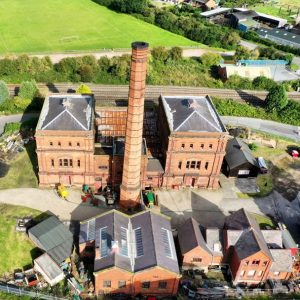
The Major Project grants were for the restoration of boiler No 1 to fully working condition at Claymills Pumping Engine House in Staffordshire, for the repair and re-erection of wooden headframe at King Edward Mine Museum, Cornwall, the restoration of the stone tower of Heage Windmill, Belper, the restoration and re-erection of 1875 passenger footbridge at the Yorkshire Dales Railway, Bolton Abbey, the repair by the Cotswold Canal Trust of an original 18th century occupation Bridge on Stroudwater Canal, and for repairs to Engine House Building at the Lancashire Mining Museum, Astley Green.
The Small Project grant was for the restoration of the rare 1874 oat roller and bucket grain elevator to working order at the Warwick Bridge Corn Mill, Cumbria.
The £161,000 offered this year brings the total value of the grants offered since the scheme started in 2009 to some £1.5m – all thanks to the generosity of our anonymous donors.
|
Details of earlier awards can be found below: Read the Article on the 2023 Restoration Grants Read the Article on the 2022 Restoration Grants Read the Article on the 2021 Restoration Grants Read the Article on the 2020 Restoration Grants Read the Article on the 2019 Restoration Grants Read the Article on the 2018 Restoration Grants Read the Article on the 2017 Restoration Grants Read the Article on the 2016 Restoration Grants |
|
| Grants awarded in 2015 were: | |
| North East Maritime Trust, for fitting out the restored life boat H.F.Swan. South Tynedale Railway, for a narrow gauge track tamper. The Thorpe Lt Railway in Co Durham, for restoration of a 15 in gauge locomotive. The Prickwillow Museum, for renovation of a Petter two cylinder engine. The Coker Rope & Sail Trust, Somerset, for restoration of machinery in the Coker rope works. The Stover Canal Trust, Devon, work on a canal graving dock. The London Wildlife Trust, work on Woodberry Wetlands gas house. | |
| Click on any of the thumbnails below to see a larger version | |
| Grants awarded in 2014 were: | |
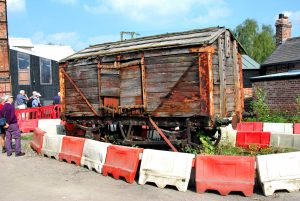 |
The Lion Salt Works relied on the rail network in parallel with the adjacent canal. The salt wagon (left) is typical of that used in the industry and is to be restored to be displayed at the revitalised salt works: £20,000 was awarded. Verdant Work’s Boulton & Watt rotative engine of 1801-2 in Dundee is one of the world’s most important remaining engines. £20,000 has been allocated for its restoration and display. The Boiler Header Pond at Crofton Pumping Station is thought to be contemporary with the 1812 Boulton & Watt engine. Restoration of the Header Pond will enable it to be used for refilling the boiler. £7,000. |
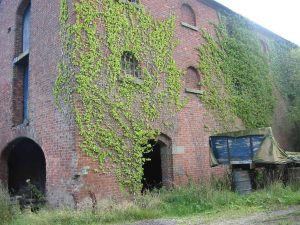 |
Two very fine Grade II listed 19th century canal warehouses at Wappenshall Wharf (left) in Shropshire designed by Thomas Telford. £20,000 has been allotted for their restoration. |
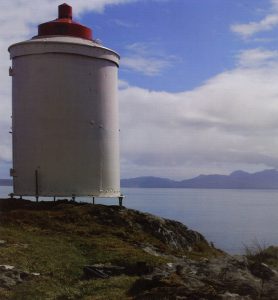 |
The Colonsay light chamber (left) was built by David A Stevenson in 1903 at Scalasaig, the main harbour and ferry terminal for the island. £4,300 has been granted for its renovation and display. |
| In 2013 four awards were made: | |
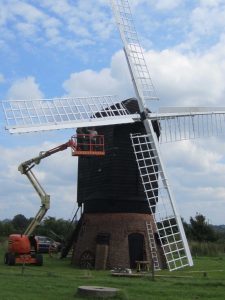 |
Further restoration of the Danzey Green Windmill (left) at the Avoncroft Museum of Buildings, £6,790. Work has been completed. Restoration of the derelict Bowbridge Lock on the Thames & Severn Canal by the Cotswold Canal Trust, £20,000. After some initial engineering problems work is now proceeding well. Restoration of a 1950 Thompson composite corridor railway carriage No 18477 by the London & North Eastern Railway Coach Association, £15,000. Work is due to start soon. Rebuilding of the 1927 Ryde Pier Tram No 2 on the Isle of Wight Steam Railway by the Isle of Wight Railway Company. £15,000. Work on this project has been delayed due to problems with the condition of the operational IOW coaches. |
| Two restoration Grants were made for 2012: | |
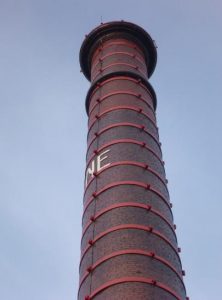 |
Grane Mill in Haslingden, Lancashire for the restoration of the top of the chimney (left) which was on the point of collapse. Grane Mill is important as one of the very few former Lancashire weaving mills that survives with its engine and boilers intact. Work is being conducted by the Heritage Trust for the North West on the long term restoration of the site. The consolidation of the chimney was one of the essential pieces of work that needed to be carried out before any progress could be made on the restoration of the rest of the site. This work was completed in the autumn of 2012. The Tramway Museum Society at Crich in Derbyshire. This grant has been made, not for trams, but for the consolidation and interpretation of rare surviving remains of a lead smelter on the Society’s Crich Tramway Village site. After a series of delays this project is due for completion in early 2015. |
| Five Grants were made in 2011: | |
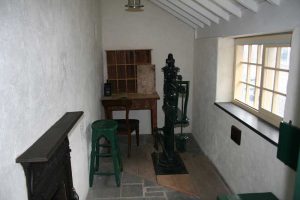 |
The Narrow Gauge Railway Museum Trust was awarded £2,000 towards the cost of rebuilding of a wagon weigh bridge (left). This project has been completed and the finished weighbridge and the associated building can be seen at Wharf Station on the Talyllyn Railway. |
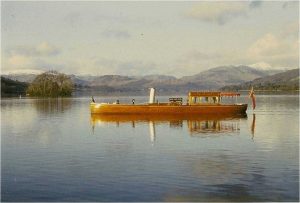 |
Lakeland Arts Trust has been awarded a grant of £15,000 towards the restoration of Steam Launch Osprey (left) at the Windermere Steam Boat Museum. Work is now well advanced on this project. |
| Mellor Archaeological Trust have had an award of £15,000 for the excavation and interpretation of the Wellington Wheel Pit at Mellor Mill. The work has been completed and the site is now open to the public. The Robey Trust have been awarded £10,000 towards the cost of moving and restoring a rare Robey undertype steam engine. The removal from the original site has been completed and work is progressing on the restoration. Ellen Road Steam Museum has been awarded £12,000 for the overhaul of the preserved Petrie Beam engine. Work on this project commenced in early 2012 and is now complete. | |
| In 2010 awards were made to the following and : | |
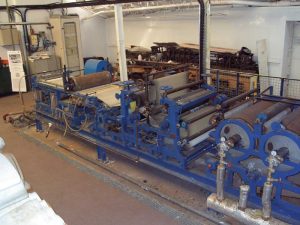 |
Repairs to the narrowboat ‘Tarporley’ at Camden Canals in London, £3,500. Restoration of a 19th century papermaking machine (left) for display in working order at Frogmore Mill, The Apsley Paper Trail, £9,870. Both projects are now completed |
| The first Grants were awarded in 2009: | |
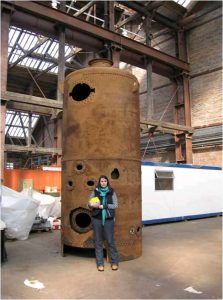 |
The Scottish Maritime Museum was awarded a grant of £2,750 towards the restoration of the original vertical cross-tube boiler from the Clyde puffer VIC 32 (left). This project is now complete and the boiler is on display. The South Yorkshire Trades Historical Trust were awarded a grant of £5,000 towards the restoration of the stone slate roof of the Hoylandswaine Nail Forge. The roof repairs have now been finished. The Beamish North of England Open Air Museum was awarded a grant of £14,000 towards the restoration of two Londonderry Chaldron Waggons. The project is completed and the waggons are on display in the colliery area at Beamish. The Boat Museum, Ellesmere Port was awarded a grant of £15,000 towards the restoration of Box Boat No 337 and boxes. After some problems sourcing timber and getting craneage the project is now complete and the boat back in the water. |
